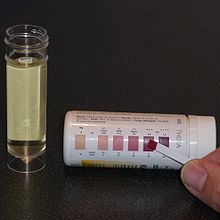Ketonuria
| Ketonuria | |
|---|---|
 | |
| Ketonuria using Bayer Ketostix | |
| Specialty | Endocrinology |
Ketonuria is a medical condition in which
It is seen in conditions in which the body produces excess ketones as an indication that it is using an alternative source of energy. It is seen during starvation or more commonly in
Pathophysiology
Ketones are metabolic end-products of
Ketone bodies that commonly appear in the urine when fats are burned for energy are
One 2010 study admits that though ketonuria's relation to general metabolic health is ill-understood, there is a positive relationship between the presence of ketonuria after fasting and positive metabolic health.[2]
Causes
- Metabolic abnormalities such as diabetes, renal glycosuria, or glycogenstorage disease.
- Dietary conditions such as starvation, fasting, low-carbohydrate diets, prolonged vomiting, and anorexia including caused by hyperemesis gravidarum.
- Conditions in which metabolism is increased, such as hyperthyroidism, fever, pregnancy or lactation.
In non-diabetic persons, ketonuria may occur during acute illness or severe stress. Approximately 15% of hospitalized patients may have ketonuria, even though they do not have diabetes. In a diabetic patient, ketone bodies in the urine suggest that the patient is not adequately controlled and that adjustments of medication, diet, or both should be made promptly. In the non diabetic patient, ketonuria reflects a reduced carbohydrate metabolism and an increased fat metabolism.
Diagnosis
A wide variety of companies manufacture ketone screening strips. A strip consists of a thin piece of plastic film slightly larger than a
| Urine value |
Designation | Approximate serum concentration | |
|---|---|---|---|
| mg/dL | mmol/L | ||
| 0 | Negative | Reference range: 0.5-3.0[6] | 0.05-0.29[6] |
| 1+ | 5 (interquartile range (IQR): 1–9)[7] |
0.5 (IQR: 0.1–0.9)[8] | |
| 2+ | Ketonuria[9] | 7 (IQR: 2–19)[7] | 0.7 (IQR: 0.2–1.8)[8] |
| 3+ | 30 (IQR: 14–54)[7] | 3 (IQR: 1.4–5.2)[8] | |
| 4+ | Severe ketonuria[10] | - | - |
Screening
Screening for ketonuria is done frequently for acutely ill patients, presurgical patients, and pregnant women. Any diabetic patient who has elevated levels of blood and urine glucose should be tested for urinary ketones. In addition, when diabetic treatment is being switched from insulin to oral hypoglycemic agents, the patient's urine should be monitored for ketonuria. The development of ketonuria within 24 hours after insulin withdrawal usually indicates a poor response to the oral hypoglycemic agents. Diabetic patients should have their urine tested regularly for glucose and ketones, particularly when acute infection or other illness develops.
In conditions associated with acidosis, urinary ketones are tested to assess the severity of acidosis and to monitor treatment response. Urine ketones appear before there is any significant increase in blood ketones;[11] therefore, urine ketone measurement is especially helpful in emergency situations.
References
- ^ Detection of Ketones and Monitoring of Diabetic Ketoacidosis-cov-7
- PMID 21165293.
- ^ "Ketone Testing-Barbara Davis Center for Diabetes" (PDF). Archived from the original (PDF) on 2010-05-30. Retrieved 2010-03-20.
- ^ Measuring Ketones in Urine-Children With Diabetes
- PMID 10634967.
- ^ a b PTS PANELS™ Ketone Test Strips Information paper PS-002588E Rev. 2 10/05 by Polymer Technology Systems
- ^ a b c Converted from molar values, using average of 103 g/mol as used in: PTS PANELS™ Ketone Test Strips Information paper PS-002588E Rev. 2 10/05 by Polymer Technology Systems, and subsequently rounded to same number of significant figures as molar value
- ^ PMID 17320448.
- PMID 11719487.
- S2CID 22767401.
- ^ BMJ Student Archive-Glycosuria and Ketonuria
